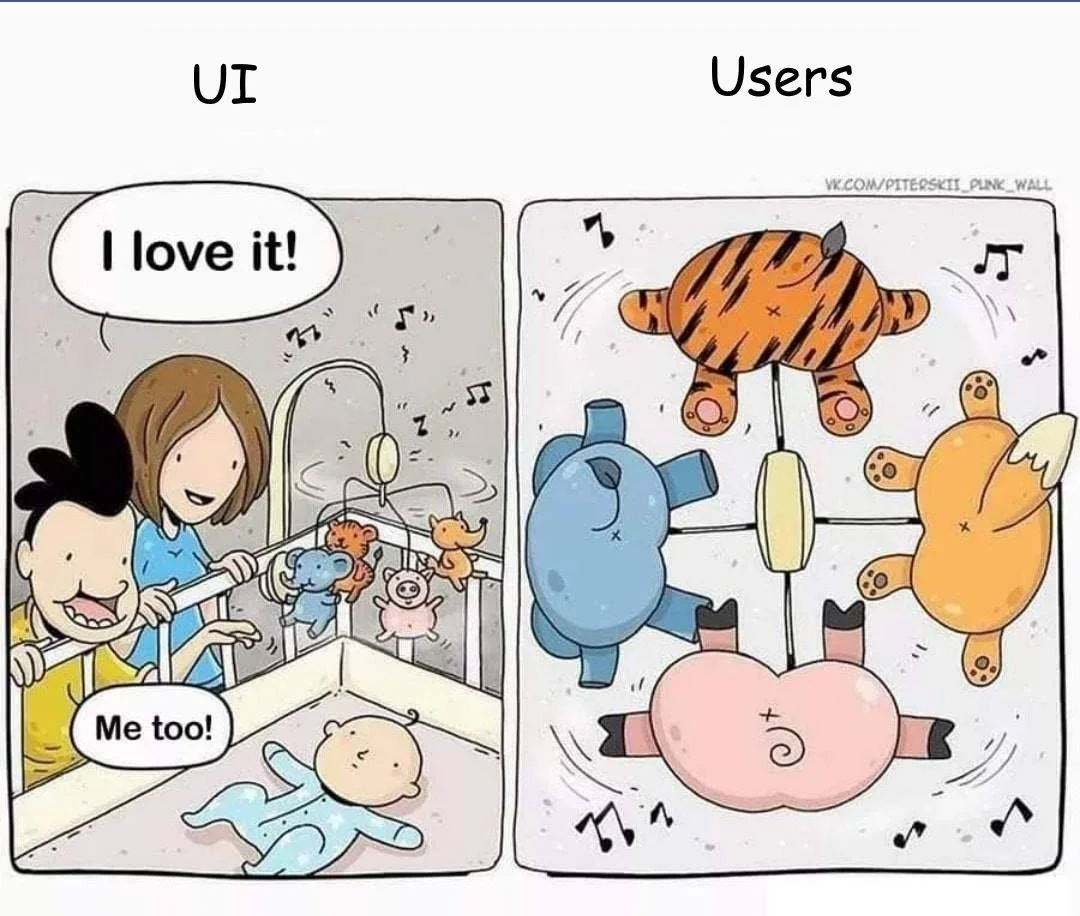What is User-Centered Design (UCD)?
We know it, you know it: the success of any product hinges on its ability to cater to the needs and preferences of its users. This is where User-Centered Design (UCD) emerges as a pivotal approach in creating exceptional digital products and experiences.
In this article, we will delve into the fundamental concept of User-Centered Design and its significance in the development and design of digital products.
What is user centered design? A brief definition
User-Centered Design - commonly abbreviated as UCD - is a design philosophy and process that places the end-users at the heart of product development.
It is a human-centric approach that seeks to understand, empathize with, and respond to the needs, behaviors, and expectations of the target audience.
By incorporating user feedback throughout the design and development process, UCD aims to optimize the usability, accessibility, and desirability of a digital product, ultimately ensuring its effectiveness and success in the market.

What are the principles of user-centered design?
UCD is guided by four fundamental principles that ensure the creation of user-friendly and effective digital experiences:
1️⃣ User Involvement
User Involvement is the backbone of User-Centered Design. To truly understand the target audience, designers and developers must actively engage with them throughout the entire product development lifecycle. Involving users from the early stages of ideation and research allows designers to gain valuable insights into their preferences, pain points, and behaviors.
By conducting user interviews, surveys, and usability tests, designers can gather firsthand information about how users interact with the product and what improvements are needed. Regular interactions with users not only help in gathering feedback but also establish a sense of empathy among the design team, allowing them to build a more profound connection with the end-users.
2️⃣ Requirement Clarification
Clear and concise requirement clarification is essential in User-Centered Design. The process begins by identifying the target audience and understanding their needs and goals. It is crucial to avoid making assumptions about user preferences and instead rely on empirical data gathered through user research.
By carefully defining the scope and objectives of the project, designers can maintain focus and avoid unnecessary features or design elements that might overwhelm users. A well-defined set of requirements serves as a guide throughout the design process, ensuring that the final product addresses the most critical user needs effectively.
3️⃣ User Feedback
User feedback is a cornerstone of User-Centered Design. Gathering feedback from users at various stages of product development helps identify areas of improvement, validates design decisions, and ensures that the final product aligns with user expectations.
User feedback can be collected through different channels, such as usability testing, surveys, and focus groups. Actively seeking and incorporating user feedback provides valuable insights and perspectives that the design team might not have considered, ultimately leading to a more refined and user-friendly product.
4️⃣ Constant Modifications
User-Centered Design is an iterative process that embraces continuous improvements. Once the product is released to users, the journey does not end; it is an ongoing cycle of constant modifications based on feedback and changing user needs.
Analyzing user behavior and interaction patterns allows designers to identify pain points and areas that require enhancement. Regular updates and improvements based on user feedback demonstrate the commitment to providing the best possible user experience, which fosters user loyalty and satisfaction.

Beyond UCD: new frontiers in User-Centered Thinking
User-Centered Design continues to evolve alongside the changing landscape of technology, business, and society. While the core principles of UCD remain vital, modern product teams are integrating complementary approaches that expand the concept of user-centricity beyond usability alone.
DesignOps is one such extension. As organizations grow, DesignOps helps scale UCD by streamlining workflows, aligning teams, and embedding user-centered practices into the entire product lifecycle...making design more operational and efficient.
Inclusive Design and Ethical Design broaden the scope of user research to consider diversity, equity, and the potential social impacts of design decisions. UCD today must go beyond the “average user” and actively design for people with different abilities, backgrounds, and contexts, ensuring accessibility and avoiding bias in digital products.
Advancements in AI-driven UX Research are also transforming how teams gather and analyze user feedback. Tools powered by artificial intelligence now provide deeper insights through session recordings, behavioral heatmaps, and sentiment analysis, allowing teams to identify friction points and opportunities for improvement faster and with greater accuracy.
Together, these emerging practices extend the foundations of UCD and empower teams to build more thoughtful, inclusive, and scalable digital experiences.
How you can apply user centered design in your designs and digital products
By empathizing with users, involving them throughout the design lifecycle, and consistently iterating based on their feedback, digital product creators can ensure that their designs are intuitive, enjoyable, and effective. But how can you apply UCD in your digital products?
- Understand Your Users: the first step in applying User-Centered Design is gaining a deep understanding of your target users. Conduct thorough user research through surveys, interviews, and observations to identify their goals, pain points, and behaviors. Create user personas that represent different segments of your audience, which will help you empathize and design for their specific needs.
- Define Clear Objectives: once you have a comprehensive understanding of your users, clearly define the objectives of your digital product. Establish specific goals and key performance indicators (KPIs) that align with user needs. Setting measurable targets will keep the design team focused and guide the decision-making process.
- Involve Users from the Start: incorporate user involvement early in the design process. Engage users in brainstorming sessions, workshops, and co-creation activities. Their input can inspire fresh ideas and provide valuable insights that may have been overlooked otherwise. Collaborative design sessions also instill a sense of ownership and understanding among the design team.
- Create Prototypes for Feedback: build interactive prototypes that represent the key features and functionalities of your digital product. These prototypes can be tested with real users, allowing you to gather feedback on the user experience and identify areas that need improvement. Rapid prototyping enables quick iterations, saving time and resources in the long run.
- Conduct Usability Testing: usability testing is a critical phase in User-Centered Design. Observe how users interact with your prototype or early product version, and analyze their behaviors and pain points. Usability testing helps validate design decisions and ensures that the final product is intuitive and user-friendly.
- Iterate and Improve: based on user feedback, iterate on your designs to address any identified issues and enhance the overall user experience. Embrace constant modifications and improvements to refine your digital product continuously. Remember that User-Centered Design is an iterative process, and the design journey continues even after the product's launch.
- Consider Accessibility: a truly user-centered design is accessible to all users, including those with disabilities or special needs. Ensure that your design complies with accessibility standards, making it inclusive and accommodating for a diverse audience.
- Maintain Consistency: consistency is key to a positive user experience. Establish design patterns, layout principles, and interaction guidelines that remain consistent throughout the product. A coherent user interface fosters familiarity, making it easier for users to navigate and engage with your digital product.
- Gather Data and Analytics: once your digital product is live, continue to collect data and analytics on user behavior. Analyze the data to gain insights into user engagement, pain points, and feature usage. Use this information to inform future updates and enhancements.

What are the benefits of using UCD?
By focusing on the needs, behaviors, and expectations of users, UCD offers a lot of benefits that contribute to the success of a product and the overall growth of your business:
- Enhanced User Satisfaction: by empathizing with their needs and preferences, UCD ensures that the final digital product is tailored to provide an exceptional user experience. When users find a product intuitive, useful, and enjoyable, their satisfaction increases, fostering loyalty and positive word-of-mouth referrals.
- Reduced Development Costs: by involving users early on and making incremental improvements based on their feedback, potential issues and usability problems can be identified and addressed promptly. This iterative approach helps in reducing development costs by avoiding major redesigns or post-launch fixes.
- Increased Product Adoption and Engagement: when users feel that the product was designed specifically for them and addresses their pain points, they are more likely to engage with it regularly and become advocates for the product.
- Improved Market Competitiveness: by consistently meeting user needs, UCD allows products to stand out in the market and gain a reputation for being user-friendly and reliable.
- Enhanced Accessibility and Inclusivity: when products are designed to accommodate users with disabilities or diverse needs, it expands the potential user base and fosters a sense of social responsibility, creating a positive brand image.
- Better Decision Making: by basing design decisions on real user feedback rather than assumptions or personal preferences, development and design studios can make more informed and objective choices, leading to better overall product outcomes.
- Reduced Risk of Failure: by involving users throughout the design process, UCD minimizes the risk of launching a product that doesn't meet user expectations or needs. Early feedback and validation help in identifying potential pitfalls and correcting course before investing substantial resources in development.
- Customer-Centric Culture: adopting User-Centered Design encourages a customer-centric culture within the development and design studio. This cultural shift fosters collaboration, empathy, and a shared commitment to creating meaningful products that positively impact users' lives.
- Long-term Customer Loyalty: User-Centered Design, with its focus on user satisfaction and continuous improvements, fosters long-term customer loyalty, which contributes to sustained business growth.
User-Centered Design as a strategic lever
User-Centered Design is a powerful tool for reducing risk and increasing product success. When embedded into the product strategy, UCD helps teams make smarter, faster, and more customer-aligned decisions throughout the product lifecycle.
During the discovery phase, UCD practices like interviews, surveys, and usability audits help uncover real user pain points before a single line of code is written. This early validation prevents teams from solving the wrong problems or building features no one needs.
UCD also plays a key role in achieving product-market fit. By focusing on real user needs and continuously iterating based on feedback, teams can refine the core value proposition and ensure that the product resonates with its intended audience.
When it comes to product roadmapping, UCD ensures priorities are grounded in evidence, not assumptions. User insights help define what features truly matter, reduce uncertainty, and validate hypotheses with real-world behavior.
Incorporating UCD into strategic decisions leads to products that not only work, but that users actually want to use. It aligns design with business outcomes, improves cross-functional collaboration, and supports sustainable growth through informed iteration.
User-Centered Design is a mindset. It’s about designing with empathy, thinking critically about real user problems, and aligning every decision with both human needs and business objectives.
Whether you're launching a new product, scaling an existing one, or trying to improve a single feature, UCD provides a clear, structured path to delivering value that actually resonates.
At Acid Tango, we believe in designing products with purpose, backed by real user insights and validated through constant iteration. If you're ready to build something users love (and that works for your business) we're here to make it happen.
Frequently Asked Questions (FAQs)
Is User-Centered Design only for designers?
Not at all. UCD involves designers, developers, product managers, marketers, and even stakeholders. It’s a collaborative approach where everyone contributes to building a better user experience based on real user needs.
How does UCD differ from Human-Centered Design (HCD)?
They are very similar and often used interchangeably. HCD is a broader concept that can be applied beyond digital products, while UCD specifically focuses on digital product design and usability. Both emphasize empathy, research, and iteration.
Can UCD be applied in Agile environments?
Yes—UCD fits very well with Agile. Iterative cycles in Agile allow for continuous user feedback and design refinement. The key is to integrate research and testing into the sprints effectively.
How do you balance business goals with user needs?
User needs and business goals aren’t mutually exclusive. UCD helps align both by identifying pain points that, when solved, drive engagement, satisfaction, and ultimately, business success. Prioritizing features that serve both user value and business impact is key.
What if we don't have time or budget for user research?
Skipping user research can be costly in the long run. However, you can still apply lightweight methods like guerrilla testing, simple surveys, or internal feedback loops. Even limited insights are better than designing based on assumptions.
How often should we update our product based on user feedback?
Continuously. UCD is an ongoing process. Regularly collecting and acting on feedback—through usability tests, analytics, or support tickets—helps keep your product relevant and user-friendly.
What are some quick wins to make a product more user-centered?
- Simplify navigation and content hierarchy
- Improve accessibility (contrast, keyboard navigation, screen reader support)
- Add contextual help or onboarding
- Reduce cognitive load with clearer CTAs and less clutter
- Test early with real users—even informally
